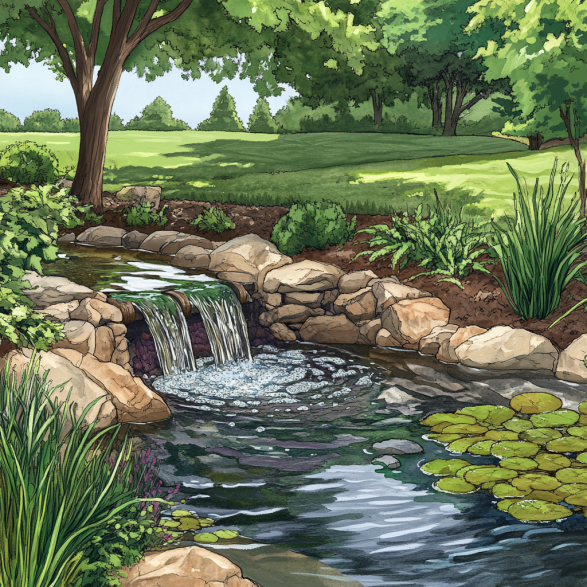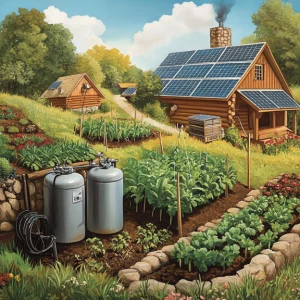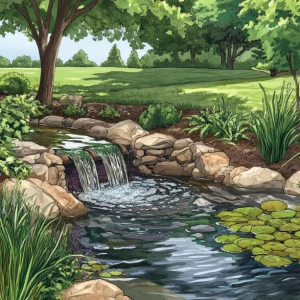Water has an undeniable power to transform any landscape, offering tranquility, movement, and a touch of natural beauty to your outdoor space. Whether you’re looking to create a serene retreat or simply enhance your garden’s aesthetic, incorporating a water feature is a fantastic choice. But as you embark on this journey, one question inevitably arises: should you choose a natural water feature that blends seamlessly with the environment, or go for an artificial one that allows for greater design flexibility and ease of maintenance? Both options have their own charm and practical benefits, making the decision a matter of balancing your aesthetic preferences, available space, and long-term goals.
In the debate of natural vs. artificial water features in your land, it’s essential to consider not only the visual impact but also the ecological and practical aspects. Natural water features, such as ponds and streams, can attract wildlife and create a habitat that evolves with the seasons. On the other hand, artificial features like fountains or constructed ponds offer more control over water quality, design, and maintenance. Understanding the differences between these two types of features can help you craft the perfect oasis that suits your personal style and the unique characteristics of your land.
1. Understanding Water Features
Water features come in two primary forms: natural and artificial. Both have distinct characteristics that contribute differently to the overall look and feel of your landscape.
- Natural Water Features: These elements are typically modeled after what you’d find in nature. Streams, ponds, and waterfalls are great examples of natural water features. They are designed to seamlessly blend into the landscape, creating a serene, natural ambiance that feels as though it’s always been there. These features often support wildlife, like fish or frogs, and encourage plant growth, making your landscape more biodiverse.
- Artificial Water Features: On the other hand, artificial water features are man-made and offer a structured, controlled aesthetic. Fountains, artificial ponds, and water walls fall into this category. These installations allow for greater creativity in design, often featuring unique shapes, materials, and even lighting effects that highlight the feature day and night. Artificial water features are perfect for adding a modern, artistic touch to your space, with the added benefit of being easier to control in terms of water quality and flow.
Visual comparison of natural and artificial water features could provide a better understanding of their differences in aesthetic and functional appeal.
2. Benefits of Natural Water Features in Landscaping
Natural water features come with several advantages that make them a popular choice for homeowners who appreciate the beauty of organic elements in their landscapes.
- Ecological Benefits: One of the most compelling reasons to choose a natural water feature is the positive ecological impact. Natural ponds and streams can serve as habitats for various species, fostering biodiversity. Birds, insects, fish, and other animals are drawn to these environments, which provide food, water, and shelter.
- Aesthetic Appeal: The organic, free-flowing nature of a pond or stream brings a sense of peace and serenity that’s difficult to replicate with artificial installations. Natural water features can blend seamlessly into the environment, making them a great choice for homeowners who want their landscape to feel like an extension of the surrounding nature.
- Mental and Physical Health Benefits: Studies have shown that spending time near natural water can reduce stress, improve mood, and boost overall mental health. The gentle sound of water can also serve as white noise, helping block out distractions and creating a calming atmosphere ideal for relaxation or meditation.
Incorporating visuals that highlight the beauty of natural water features will further underscore the aesthetic and emotional benefits they bring to a landscape.
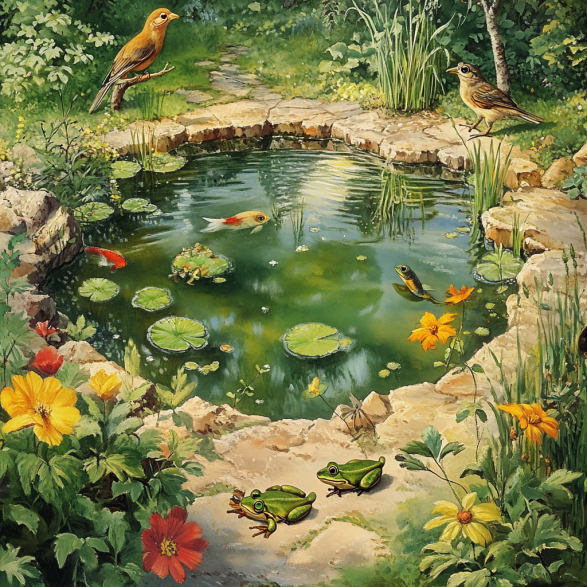
3. Exploring Artificial Water Features
Artificial water features have a charm of their own, offering several key benefits that make them a practical and stylish choice for many landscapes.
- Design Flexibility and Creativity: One of the standout features of artificial installations is the creative freedom they provide. Whether it’s a sleek, modern fountain or a whimsical water wall, artificial features allow you to incorporate unique designs that match your personal style and complement the architectural elements of your home.
- Control Over Water Quality and Safety: Artificial features are easier to manage when it comes to water quality. With filtration systems and pumps, you have control over the cleanliness and safety of the water, ensuring it remains crystal clear. This makes artificial ponds or fountains more hygienic and easier to maintain, especially in urban areas where natural water may be subject to pollutants.
- Ideal for Small Spaces and Indoors: Artificial water features are perfect for smaller yards or even indoor spaces where a natural pond or stream may not be feasible. A small fountain or water wall can add a touch of elegance and tranquility to a patio or garden without taking up too much space.
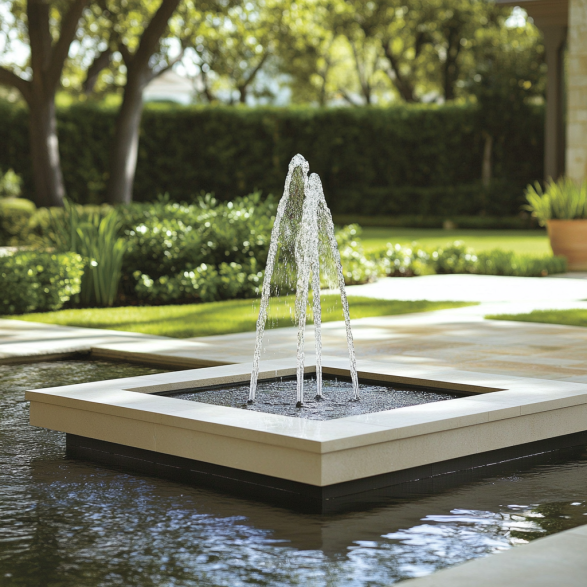
4. Installation and Maintenance
Installing and maintaining a water feature may seem daunting, but with the right approach, it can be a smooth process. Whether you’re going the natural or artificial route, here’s what you need to know.
- How to Install Artificial Ponds in Your Garden: Installing an artificial pond is a manageable DIY project with the right tools. First, choose a suitable location and dig a hole according to your pond’s size. Next, line the pond with a waterproof liner and install a pump to keep the water circulating. Add decorative elements like rocks, aquatic plants, and lighting to enhance the overall design.
- Maintaining Water Quality in Backyard Fountains: Regular maintenance is key to ensuring your water feature stays beautiful and functional. Clean the pump and filters regularly, and use water treatments to prevent algae buildup. For fountains, it’s essential to monitor water levels and ensure the pump is fully submerged to avoid burnout.
- Challenges and Solutions for Both Natural and Artificial Features: While natural features may attract wildlife and create an ecosystem, they can also invite unwanted debris and algae. Regular maintenance, such as clearing fallen leaves or adding oxygenating plants, can keep the ecosystem in balance. For artificial features, the main challenges involve pump maintenance and keeping water clean, both of which can be addressed with routine cleaning and care.
5. Cost Comparison
One of the most important factors when choosing between a natural and artificial water feature is cost.
- Initial Setup Costs: Natural water features typically have lower upfront costs, as they rely on the land’s natural contours and ecosystems. However, larger projects involving excavation or liners can add to the cost. Artificial features, on the other hand, often come with higher initial costs due to materials, pumps, and custom designs.
- Long-Term Maintenance Expenses: Natural water features can be more self-sustaining once established, but they may require more frequent clean-up and occasional ecosystem management. Artificial features generally require less maintenance, but electricity for pumps and regular cleaning supplies are ongoing expenses.
- Budgeting Tips for Homeowners: To make the most of your investment, it’s important to consider both the initial cost and the long-term expenses. If you’re on a budget, opt for a smaller installation with simple materials or explore DIY options.
6. Eco-Friendly and Sustainable Practices
Whether you choose natural or artificial, there are ways to make your water feature eco-friendly and sustainable.
- Water Conservation Techniques in Landscape Design: One way to reduce the environmental impact of your water feature is by using water-conserving techniques like rainwater harvesting or installing a recirculating pump that minimizes water waste.
- Selecting Eco-Friendly Materials for Artificial Water Features: For artificial installations, look for sustainable materials such as recycled liners or energy-efficient pumps to reduce the carbon footprint of your water feature.
- Supporting Local Wildlife with Natural Water Features: Natural water features support local ecosystems by providing water and shelter for wildlife. You can enhance this by planting native vegetation around your pond or stream, which will attract pollinators and other beneficial species.
Conclusion
Water features have the power to transform a landscape, whether through the organic charm of a natural pond or the sleek sophistication of an artificial fountain. By understanding the benefits, costs, and maintenance requirements of each, you can make an informed decision that suits your personal style and the characteristics of your land. Ultimately, the choice between natural vs. artificial water features comes down to how you balance beauty, sustainability, and practical considerations in your landscape design. With the right planning and care, your water feature will become a source of tranquility and joy for years to come.
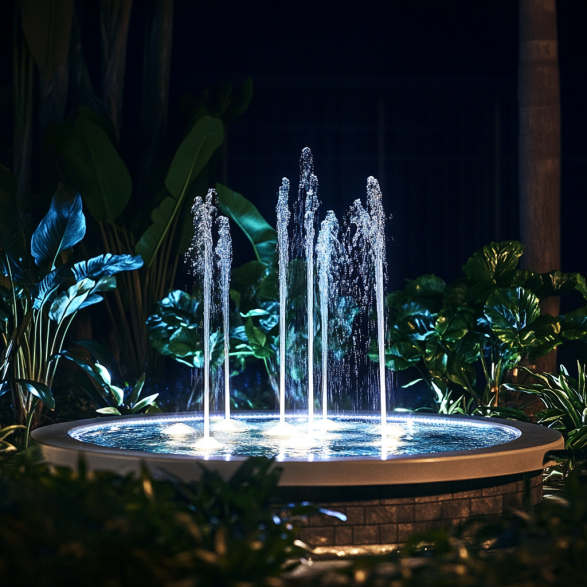
FAQs
What are the main differences between natural and artificial water features?
A: -Natural water featureslike ponds, streams, and waterfalls are designed to blend into the environment and often support local wildlife. They require minimal intervention once established but may need occasional upkeep to maintain their ecosystem.
– Artificial water features like fountains, water walls, and man-made ponds offer greater design flexibility, allowing for more control over water quality and flow. They often require more maintenance in terms of cleaning filters and pumps but are ideal for smaller or more structured spaces.
Which water feature is easier to maintain: natural or artificial?
A:- Artificial water features generally require more structured maintenance, such as cleaning pumps, checking filters, and treating water to prevent algae buildup. However, this maintenance is predictable and can be planned for.
– Natural water features are often more self-sustaining, but they can attract debris like leaves and might require occasional water quality checks to maintain balance in the ecosystem.
Are natural water features more environmentally friendly than artificial ones?
A:Yes, natural water features tend to be more environmentally friendly as they create habitats for wildlife and can support biodiversity. However, artificial water features can also be eco-friendly if designed with sustainable materials and energy-efficient pumps.
Can I have a water feature in a small backyard?
A: Absolutely! Artificial water features like small fountains, water walls, or even a mini pond can fit into compact spaces. They are often designed to maximize aesthetic appeal while taking up minimal space.
How much does it cost to install a water feature?
A:The cost varies widely depending on the size, type, and complexity of the water feature. Natural features often have lower initial costs, especially if you’re working with the existing landscape. Artificial water features can be more expensive upfront due to materials and equipment, but their maintenance costs may be lower over time
Do I need a permit to install a water feature?
A: It depends on your location and the size of the feature. For small, artificial installations like fountains or small ponds, you usually won’t need a permit. However, larger features, especially those that involve significant excavation or use natural water sources, may require permits or approval from local authorities. Always check your local building regulations before starting a project.

